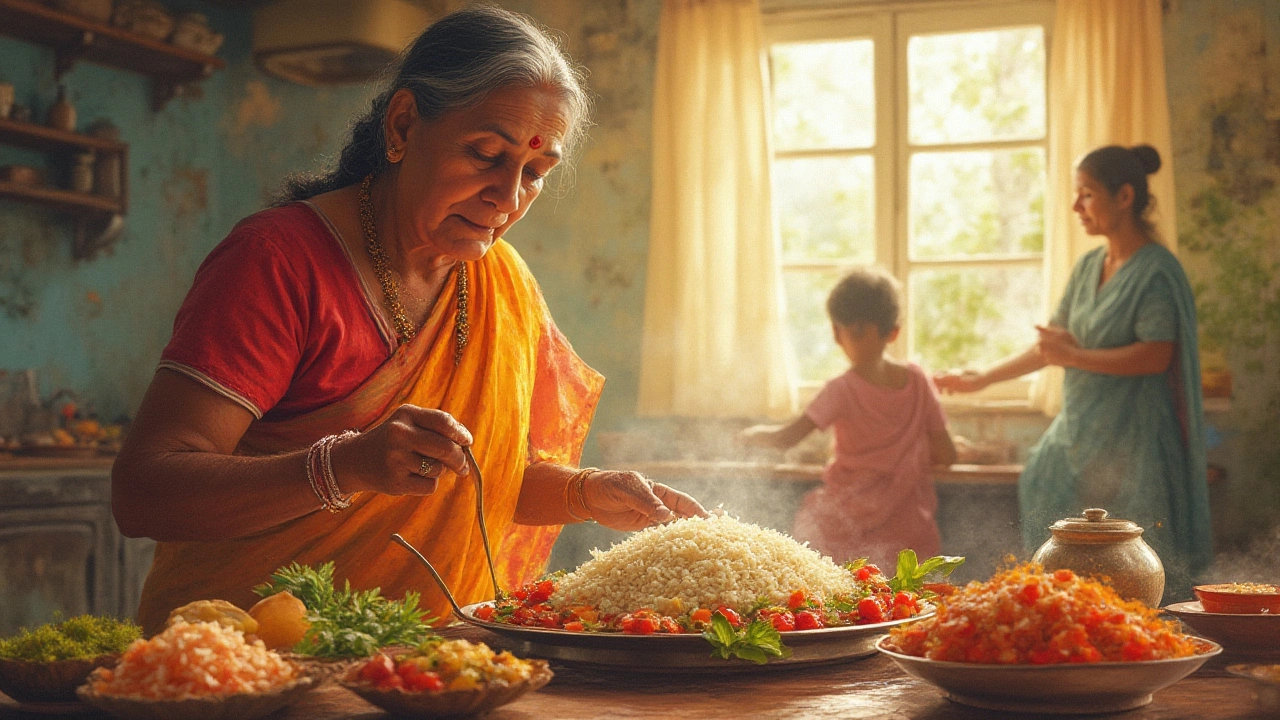Ayurvedic Eating: How to Eat Properly for Better Health and Digestion
 Jul, 23 2025
Jul, 23 2025
Picture this. My eight-year-old, Zia, turns to me at dinner and asks why her grandma eats so slowly, always sitting on the floor, while she races through her sandwich in front of the TV. Turns out, her grandma might be onto something ancient. Ayurveda, the science of life that’s guided people in India for over 3,000 years, doesn’t just focus on what you eat but how, when, and why you eat, too. Decoding Ayurveda’s eating rules might sound mystical, but they’re pretty practical—and packed with science-backed lessons that modern dining mostly ignores. If you’ve ever had your stomach rebel after scarfing down a big meal or felt sluggish after a late dinner, you’re not alone. Ayurveda didn’t just notice these patterns ages ago—it built a whole system around fixing them. Ready for food habits more forgiving to your gut and your energy?
Understanding Ayurvedic Principles of Eating
At its core, Ayurveda doesn’t believe in one-size-fits-all meals. The system revolves around your unique constitution, called your 'dosha.' Think of doshas as your body’s bio-energetic fingerprint. There are three: Vata (air + space), Pitta (fire + water), and Kapha (earth + water). Each person has all three, but usually one dominates. Here’s the fun part—your dosha can help determine which foods, routines, and flavors are most compatible for you.
Ayurveda says eating isn’t just about nutrients. It’s a ritual, designed to keep your mind and body humming. The process revolves largely around three concepts: Agni (digestive fire), Ojas (vitality), and Ama (toxins). Strong Agni helps break down foods fully, so you get max nourishment. Low Agni equals weak digestion and toxin buildup. Western science is warming up to this, too; research shows that mindful eating and healthy meal timing boost gut health and reduce the risk of chronic disease—a nod to Ayurveda’s ‘old news.’
Each taste—sweet, sour, salty, bitter, pungent, and astringent—serves a purpose in Ayurveda. Instead of avoiding certain flavors, balance all six in your daily diet. A typical Ayurvedic plate might mix lentils (sweet), lime (sour), sea salt, greens (bitter), ginger (pungent), and beans (astringent). That’s not just for taste; this blend supports your digestion, energy, mood, and immunity.
Meal timing matters a ton. Ayurveda advises eating your largest meal at midday when your digestive fire (Agni) is at its mightiest. Ever noticed how your body handles a heavy lunch better than a midnight burger? There’s data behind that—studies show our digestion runs strongest between 10 am and 2 pm.
Another foundational rule: eat only when hungry. Ayurveda teaches us to listen to the body—true hunger signals that fuel is needed, not just a midday boredom snack. And when you’re eating, focus only on your meal, not your phone or TV. Distraction at meals hinders digestion; mindful eating can even improve nutrient absorption, recent Harvard research confirms.
| Ayurvedic Eating Principle | Modern Science Perspective |
|---|---|
| Eat largest meal at lunch | Midday digestion strongest (Chronobiology research) |
| Balance 6 tastes | Variety improves nutrient intake (NIH study 2020) |
| Eat when hungry | Reduces overeating, better metabolism (Yale study 2019) |
| Mindful, undistracted eating | Improves digestion, gut health (Harvard 2021) |
| Warm, cooked food preferred | Easier on digestion, supports gut microbiome (Gut Journal, 2022) |
Rules can differ for each dosha. For fiery Pitta types, cooling foods like cucumber and mint bring balance; Vatas thrive on grounding, warm meals like soups and stews; Kaphas benefit from light, spicy fare. But before getting caught up on specifics, Ayurveda starts with universal eating habits that help everybody.

Step-by-Step: How to Eat Properly According to Ayurveda
Think there’s a secret Indian formula hidden in Ayurveda? Not really—just a bunch of simple, actionable tweaks. Yes, you may need to rethink some habits, but nothing here feels restrictive. Let’s get to the rituals the sages claimed were non-negotiable for healthy eating, and why those rules still fit our turbo-charged 2025 lifestyles.
- Always sit down to eat. Sitting, not standing or wandering, tells your body food is coming and preps your gut for digesting. Lots of families (like mine) still practice this in Indian homes—maybe not cross-legged, but at a proper table. Studies reveal this habit improves satiety, making you less likely to overeat.
- Eat in a calm, pleasant space. Ayurveda discourages multitasking at meals. Clutter, loud TV, or arguments at dinner raise stress hormones, which can slow digestion or cause acid reflux (thanks, cortisol).
- Start the meal with gratitude. This isn’t about religion; it’s about priming the mind. Acknowledging your food, even briefly, centers your attention. Turns out, saying thanks or pausing before eating can help regulate your appetite and increase meal satisfaction, studies at UC Davis show.
- Chew thoroughly. Ayurveda recommends chewing each bite 20–30 times. Sounds obsessive, right? But breaking food down well lets your saliva start the digestive process, which reduces bloating and improves the absorption of nutrients.
- Favor warm, cooked foods. These are simply easier on the digestive tract. Raw salads can stress weaker digestions, particularly for Vata people. Warm soups, stews, or stir-fries? These go down easier and help you feel truly nourished.
- Don’t rush meals. Too-fast eating overloads your stomach before it signals your brain “hey, we’re full!”—hence, accidental overeating. The old rule applies: 20 minutes for your brain to catch up, so slow down and savor.
- Don’t drink too much water with your meal. Ayurveda warns that guzzling water can douse your digestive fire. Sip small amounts if needed, but wait 30 minutes post-meal for chugging. Modern gastroenterologists see similar effects when large drinks dilute stomach acids.
- Eat meals at consistent times each day. Just like our bodies love regular sleep, digestion thrives on routine. Irregular meal timing disrupts hormone rhythms and spikes blood sugar. A 2022 JAMA study found erratic eating patterns lead to higher metabolic disease rates.
- Stop before you feel totally stuffed. That 80% full metric isn’t just a Japanese thing—it’s central in Ayurveda, too. Leaving room gives your Agni space to finish digesting without struggle. If you get heartburn or sluggishness after eating, this simple trick might solve it.
- Listen to your body. If a meal leaves you tired, bloated, or gassy, Ayurveda suggests your Agni didn’t handle it well. Adjust until meals leave you feeling light and refreshed.
There are dos and there are “don’ts” in Ayurveda, too. Don’t eat too late at night; your Agni is at its weakest from dusk onward, and heavy, late-night meals are prime suspects for poor sleep, weight gain, or morning grogginess. And eating when stressed or upset? Huge no—Ayurveda says negative emotions actually disrupt digestive enzymes, a point echoed in recent gut-brain axis research. Even 5 minutes of deep breathing before eating can flip your nervous system from stressed to rested.
If you’re curious about food combining (an old-school Ayurvedic hot topic), certain combos—like milk with sour fruits, or melons with grains—are discouraged. These combos, Ayurveda says, cause ‘Ama’ or undigested leftovers that gum up the system. New studies show certain enzymes are blocked by some combos, so the guidelines aren’t just superstition.
So how do you apply this if you’re a non-vegetarian, have allergies, or are always busy? Ayurveda adapts. If you love chicken, eat it in moderation at lunch and savor each bite. Vegan or gluten-free? No problem—just apply the same eating rules above with foods that work for you.

Practical Tips and Modern Life Hacks for Ayurvedic Eating
I get it—life these days is full of “quick fixes,” delivery apps, and back-to-back meetings. Eating Ayurvedically in 2025 isn’t about exotic shopping lists or spending hours at the stove. It’s about smart habits that fit your crazy schedule. Let’s get granular.
- Pre-plan your biggest meal between 11 am and 2 pm. If you’re at work, meal-prep something warm (think grain bowls or a simple soup you can microwave). No access to a kitchen? Many grocery stores sell ready-made stews or heated rice bowls now—aim for warm, balanced meals, not cold sandwiches.
- Make breakfast light but nourishing—warm porridge, fresh fruit (in season), or stewed apples with cinnamon is classic. Save the heaviest meal for midday, when your body’s ready.
- If dinner with family is a non-negotiable, keep it light: veggie stir-fry, khichdi (lentil-rice mash), or a broth-based soup. Avoid fried, heavy foods close to bedtime, since metabolism slows at night.
- Batch-cook or use a slow cooker for stews, soups, and one-pot meals. Freeze in single-serve portions for fast, healthy options all week.
- Even on busy days, take 5 minutes before lunch or dinner: stand up, shake out your stress, and take a few calm breaths before eating. Sounds silly, but this one habit can transform your digestion.
- Make mealtime mindful. Even if you eat at your desk, close your laptop for 15 minutes. Focus on taste, aroma, and texture. Studies found mindful lunches boost afternoon productivity (Stanford, 2023).
- Invest in a seasonings kit with basics like turmeric, cumin, coriander, ginger, and black pepper. These staples enhance the taste and support digestion, especially in colder weather.
- Prepare a daily spice tea for sluggish digestion: boil water with fresh ginger, fennel, and a squeeze of lemon. Sip it 30 minutes before your meal to wake up your Agni (digestive fire).
- If heartburn or gas is common, add more bitter greens and avoid heavy dairy or fried food after noon. This brings the fire down gently.
- Not sure about your dosha? Most people are a mix. Eat a varied, balanced diet according to the rules here, and watch how your body responds.
What about eating out or travel? The old Ayurvedic doctors didn’t deal with airports or fast food courts, but their rules adapt. Choose freshly cooked options over cold salads or massive combo meals. Buffets? Try a small portion of everything, focus on cooked items, and skip mixing dairy with fruit or heavy meats in a single plate.
And, a trick I use with my daughter Zia—offer choices. Present a couple of healthy, seasonal cooked foods, let her pick, and eat together at the table. Meals are more about connection and awareness than perfection. Ayurveda isn’t strict or joyless; it’s a toolkit to help you feel better meal after meal.
So next time you eat, remember: slow down, enjoy every bite, stay present, savor warm, fresh food, and notice how you feel after. Those ancient rules? Turns out, they’re the original wellness hacks—no apps, superfood powders, or supplements needed. Just mindful, Ayurvedic diet principles that work, whether you’re eight or eighty.